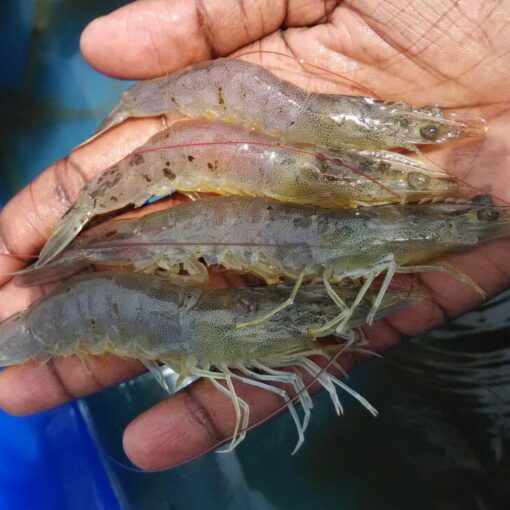By Aquaculture Magazine Editorial Team
As the world seeks sustainable protein sources, shrimp aquaculture is surging ahead becoming a cornerstone of global food security. Driven by innovation, the sector has evolved from traditional methods to intensive, high-tech systems that balance biology, economics, and environmental care. With rising demand, shifting market dynamics, and urgent sustainability challenges, the shrimp industry stands at a transformative crossroads, one where science, strategy, and adaptability will define its future.
The aquaculture sector is rapidly expanding, playing a key role in food security by providing quality animal protein. This industry has shifted from semi-intensive to intensive farming to increase production. Among the fastest-growing agri-food sectors, the shrimp industry has seen remarkable growth due to rising global trade. Farmers are adopting intensive systems with better biosecurity to mitigate pathogen risks.
Key factors enhancing intensification include advanced nutrition and breeding programs, crucial for sustainable expansion. Balancing biological and economic aspects is essential due to the sector´s sensitivity to multiple inputs. Super-intensive systems require improved nutritional strategies and robust breeding lines tailored to demanding environments (Emerenciano et al., 2022).
Shrimp farming is a preferred practice due to its rapid growth, short culture period, and high consumer demand. Market factors such as aquafeed costs and market access influence global shrimp production, with an expected compound annual growth (CAGR) of 4.8% in 2024, down from 5.8% (2011-2021) (Jory, 2023) (Figures 1 and 2).

Fish meal and fish oil scarcity limit industry growth, as farmed crustaceans consume 30% of global fishmeal (Johannessen, 2023). The Peruvian anchovy shortage reduced global fishmeal and fish oil supply by 10% and 30% respectively, increasing prices (White, 2023; LeBlanc, 2023; Miranda, 2023).

Sustainability challenges include environmental concerns, lack of certification, and market fluctuations. Developed nations now monitor shrimp imports for transparency. Certified, traceable shrimp from regulated farms can stabilize prices and ensure sustainable production (Asian Development Bank 2022; Villarreal, 2023).
Region-Specific Shrimp Production and Trading Activity
Global shrimp production is projected to grow by 4.8% in 2024, reaching 5.88 million metric tons (MMTs). The top five shrimp-producing countries: Ecuador, China, India, Vietnam, and Indonesia, account for 74% of global production (Jory, 2023). Increased shrimp consumption in the United States (U.S.) has driven exports up by 123%, from USD 225.21 million (2013-2014) to USD 501.57 million (2022-2023) (CAA, 2023).
Pacific white shrimp dominates the market, comprising 80% of global production due to its superior yield, shorter culture period, and disease resistance (Aquaculture Asia Pacific 2024). Black tiger shrimp production, however, is also, adding 550,000 tons in 2023 and projected to exceed 600,000 tons in 2024 (Jory, 2023). The industry faces global price declines, with Ecuador´s shrimp sector expected to decelerate to 7% growth in 2024, largely due to El Niño risks (Krishna-kumar, 2023). Meanwhile, Asia is rebounding after a 2023 production decline, with projected growth of 4% in 2024. India´s shrimp production is set to grow 2%, while Vietnam is expected to recover with a 6% increase (Gairn, 2023).
The U.S. is investigating Ecuador, India, Indonesia, and Vietnam for anti-dumping and countervailing duties, potentially shifting imports to Thailand. China and Japan may absorb redirected exports (Arunmas, 2023).
Asia
Shrimp production in Asia fell by 3% in 2023 but is expected to grow by 4% in 2024. China´s shrimp industry benefits from greenhouse and recirculatory aquaculture systems. In India, Pacific white shrimp production declined 12% in 2023, though a 2% rebound is expected in 2024. Vietnam saw a 15% drop in 2023 but is projected to recover with 5% growth. Indonesia anticipates a 3.5% increase in 2024 after a 5% decline in 2023 (Jory, 2023). India´s shrimp production grew 267%, from 0.322 MMTs (2023-2014) to 1.184 MMTs (2022-2023). The industry´s export value doubled from USD 348.84 to USD 697.67 million. In India, the market, valued at USD 7.3 billion in 2022, is projected to reach USD 14 billion by 2028 (IMARC, 2023).
Pacific white shrimp dominates (60%) and slightly increased by 4%, followed by black tiger shrimp (30%) and others (10%) (Krishnakumar, 2023).
Vietnam is a major shrimp exporter, with 40% of seafood export earnings from shrimp. However, exports declined in 2023, with major reductions to the U.S. (-41%), Europe (-40%), and China (-70%). The total farming area is expected to reach 750,000 ha by 2025, with an export target of USD 10 billion (Giang, 2023).
China´s shrimp production grew 120% over 20 years, with a projected CAGR of 1.5-4.3% (2023-2028) (Mordointelligence, 2023). The country is expanding recirculatory aquaculture systems (RAS), biofloc technology, and greenhouse farming (Shriminsights, 2023).
Latin America
Latin America is the second-largest shrimp-production region. Ecuador leads production, growing 4% in 2023 to 1.49 MMTs. However, falling global prices and reduced Chinese demand have impacted revenue, causing a USD 1 billion loss in 2023 (Molinari, 2023).
Europe
Europe ranks third in shrimp imports, led by France, Spain, the United Kingdom., Italy, the Netherlands, German and Belgium. The market is projected to grow at an 8.1% CAGR (2023-2033) (Futuremarketinsights, 2023).

Modernization in Shrimp Breeding and Culture Systems
Shrimp aquaculture presents both risks and opportunities. Technological advancements have improved productivity and reduced costs though market forces remain unpredictable. Aquafeed plays a crucial role in sustainability, but challenges include fluctuating ingredient quality and mycotoxin contamination. Shrimp farmers must meet strict market requirements, particularly in high-end consumer segments (Aquaculture Asia Pacific, 2023).
Intensive shrimp farming increasingly relies on recycling waste, with successful applications in Hawaii, Florida, and Texas. Yields range from 5 to 10kg/m3 within three months. Maintaining microorganism levels and water quality is vital for indoor-intensive aquaculture (Min et al., 2009).
Shrimp aquaculture has evolved through three main phases:
(1) post2011 (early mortality syndrome),
(2) 2001-2011 (vertical integration and monoculture), and
(3) 1988-2001 (infection spread) (Dubik, 2019).
Recent advancements in technology allow for precise monitoring of feeding procedures, water quality, and production efficiency (Bostock, 2009; Parra et al., 2018).. High-tech farming reduces the need for chemicals and antibiotics, ensuring healthier shrimp. Canvas farming can increase productivity by two to three times, with a 90% success rate (Ulhaq et al., 2022).
Super-intensive shrimp farms now adopt four key strategies:
(1) biofloc aquaculture systems,
(2) RAS,
(3) hybrid Bio-RAS, and
(4) mixed trophic systems (Joffre et al., 2018; Arnold et al., 2020).
The transition to Pacific white shrimp farming has been rapid, replacing black tiger shrimp due to superior breeding and disease resistance (Dastidar et al., 2013). Innovations like aerators, pond liners, and biosecurity measures have further enhanced production efficiency (Lightner, 2005; Stentiford et al., 2012). Sustainable intensification remains key to the industry´s future growth.
Marketing Strategies, Planning, and Variability in the Shrimp Industry
Effective marketing strategies are essential for increasing global shrimp consumption. Price stability and trust in the value chain create a positive cycle, leading to higher investment and better product quality, ultimately boosting demands. Expanding demand can help mitigate price fluctuations, which are primarily driven by supply growth and reduced consumption.
Promotional efforts play a crucial role, especially as dietary habits evolve. However, globalization and rising food costs may temporarily hinder shrimp consumption in Europe and the U.S. Shrimp-producing countries should prioritize market saturation across all segments, including small and new consumers, rather than relying solely on expansion frequency (Responsible Seafood Advocate, 2023).
While shrimp demand in Europe and the U.S. is relatively low, China´s market remains strong, driven by advancements in hatcheries, nutrition, farms, and processing facilities. The main factors fueling shrimp farming growth are genetic improvements and production efficiency. A coordinated marketing plan is needed, similar to pre-competitive efforts seen in beef, pork, and dairy industries, to expand the sector and stimulate demand (Wright, 2019).
India is well-positioned in the global shrimp market, with strong international demand and growth potential. However, four key challenges threaten profitability: low shrimp survival rates, increasing disease risks, limited processing capacity for valueadded products, strict traceability regulations, and environmental stress. To sustain growth, India´s shrimp sector must urgently improve feed efficiency, wastewater management, and renewable energy use. Environmental sustainability and transparency will be critical for maintaining exports, particularly to the U.S. (Rubel et al., 2020).

Ecolabelling, Traceability, Certification, and Information and Communication Technologies (ICT) in the Shrimp Industry
Seafood consumers in developed countries are increasingly aware of the social and environmental impacts of production, prompting governments to enforce regulations for sustainable and ethical sourcing. The U.S. and Europe now product traceability to distinguish between aquaculture and wild-caught fisheries (FAO, 2007). Various ecolabels have emerged to inform consumers about production practices and environmental responsibility. The Marine Stewardship Council (MSC) pioneered fisheries management ecolabelling, while aquaculture producers have adapted to market trends due to concerns over aquaculture´s environmental impact (Islam & Bjarnason, 2008).
Leading shrimp-exporting nations, including Ecuador, Brazil, China, Thailand, Vietnam, and India, have implemented certification programs to ensure compliance with ecological and food safety standards. Examples include Brazil´s Integrated Program of Farmed Shrimp Certification (PICC), Thailand´s “Thai Quality Shrimp,” China´s Good Aquaculture Practice (GAP), and Vietnam´s Global Aquaculture Alliance (GAA) certification (FAO, 2007). Major retailers worldwide, such as Wal-Mart, Tesco, and Carrefour, support certified shrimp, aligning with global sustainability benchmarks like the Global Sustainable Seafood Initiative (GSSI) (CBI-Ministry of Foreign Affairs, 2021).
Shrimp sustainability is under scrutiny due to disease outbreaks, water contamination, and inefficient resource use. Certifications such as Best Aquaculture Practices (BAP), Global GAP, and Aquaculture Stewardship Council (ASC) are increasingly demanded by international buyers (Tran et al., 2013). Given the fragmented nature of Asian shrimp aquaculture, supply chain traceability is critical.
ICT solutions now enable precise stock management, automated feeding, and real-time water monitoring, improving efficiency and sustainability (Bostock, 2009; Gómez-Chabla et al., 2018). These innovations strengthen product traceability, linking final products to specific batches and feed sources for greater transparency.
Strategy Forward in the Shrimp Industry
The shrimp industry faces significant challenges, including environmental concerns such as sludge accumulation, chemical residues, and wastewater management. Additionally, the lack of dedicated aquaculture infrastructure forces farmers to modify agricultural systems, affecting raw material costs and global competitiveness. Disease risks, high production costs, and water quality issues further impact profitability.
Shrimp consumption and processing have declines due to trade barriers and reduced restaurant demand. Some producers are lowering stock densities to cut costs while focusing on high-quality feed and efficient nutrition management to improve profitability and sustainability.
To ensure long-term viability, shrimp farming must minimize water, energy, and chemical use, enhance traceability, and embrace sustainable practices. Governments, cooperatives, and producers must collaborate to promote responsible aquaculture. Policymakers should lead in enforcing sustainability standards, food security, and social accountability regulations (Wong, 2023).
Competitive challenges, including supplier power, new market entrants, and environmental concerns, necessitate industry-wide strategic changes (Prusty et al., 2011). Key strategies include improving value-added processing, increasing export transparency, leveraging technology, and investing in R&D. India, a major shrimp producer, must address low survival rates (55%), limited traceability, and environmental impact. Strengthening processing capabilities and transitioning to fully traceable, sustainable farming methods will be crucial to maintaining international market access.
Innovative indoor systems, such as biofloc and recirculatory aquaculture, could revolutionize shrimp farming by reducing disease risks and environmental strain. Enclosed systems enable higher stocking densities and better resource efficiency, ensuring long-term sustainability and market competitiveness (Ruble et al., 2020).
Future Prospects of the Shrimp Industry
The future of the shrimp industry is closely tied to innovations in feed, farming technology, and sustainability. Techniques like extrusion improve feed conversion ratios (FCR) and reduce pond waste. While Ecuador has adopted such innovations, countries like India lag behind due to high costs. Only 17% of Ecuadorian farms use automatic feeders and aeration, but their adoption is expected to increase exports. However, restrictions on fishmeal and fish oil —used heavily in shrimp farming— remain a major challenge (Johannessen, 2023). Alternative protein sources like insect meal, unicellular proteins, and plantbased feeds are gaining traction (van Riel et al., 2023).
To meet growing demand, the industry must adopt recirculatory aquaculture systems and genetic selection for high-growth shrimp strains that tolerate alternative feeds. Certified, traceable production will help stabilize prices and attract investment. Enhancing breeding programs through molecular-assisted selection and disease-resistant, SPF broodstock will be key to long-term sustainability.
India, the world´s second-largest shrimp producer, is poised for growth, especially after the Coastal Aquaculture Authority (Amendment) Bill 2023. Future development will rely on eco-friendly farming using technologies like biofloc, especially in inland saline areas (Haq, 2024).
However, limited value-added capacity restricts profitability. To stay competitive and tap into global markets. India must modernize processing, enforce strict quality standards, and focus on value-added exports (Stalin and Jothi, 2022).
Frozen shrimp dominates the global market driven by lifestyle changes and increased female workforce participation. India´s low labor costs and strong processing infrastructure position it well to maintain and expand its global leadership in shrimp exports.
Conclusion
Enhancing genetic diversity in farmed shrimp is key to improving resilience, growth, and overall performance. Innovations like nursery systems and water reuse can further optimize grow-out technologies. Intensifying operations near consumption centers and targeting younger consumers will support industry growth. Accreditation and certification are vital as global consumers increasingly demand responsible, sustainable, and protein-rich food options. To meet these expectations, shrimp farmers are adopting advanced, eco-friendly production methods.
While value-added shrimp products offer higher profitability, many producing countries lack adequate processing infrastructure. To remain competitive, the shrimp industry must pivot from bulk frozen exports to valued-added products. This requires adopting modern processing technologies and offering convenient, innovative options tailored to evolving market demands.
Ultimately, the long-term success of shrimp-producing nations lies in developing sustainable business models focused on value-added production. Shifting from short-term gains to long-term strategies will ensure continued growth and global market leadership in the shrimp industry.
This is a summarized version developed by the editorial team of Aquaculture Magazine based on the review article titled “GLOBAL SCENARIO OF SHRIMP INDUSTRY: PRESENT STATUS AND FUTURE PROSPECTS)” developed by: MANDAL, A. and SINGH, P., Guru Angad Dev Veterinary and Animal Sciences University, Ludhiana, Punjab, India. The original article, including tables and figures, was published on 2025, through SHRIMP CULTURE TECHNOLOGY. The full version can be accessed online through this link: https://doi. org/10.1007/978-981-97-8549-0_1










